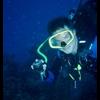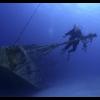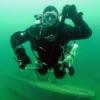
Steel Tanks
#1

Posted 18 May 2005 - 07:42 PM
#2

Posted 18 May 2005 - 07:46 PM
#3

Posted 18 May 2005 - 07:47 PM
Most come with a convertable valve. It'll usually work with DIN by removing the adapter and yoke by leaving it in.I'm planning on purchasing a couple of steel tanks. Since most come with a din value I want to know what to do. I like to travel out of country, so I don't want to change out my regulator. Is it safe to change the value on the tank? And how much does it usually run?
Who's tanks? I know PST come std. with the DIN/Yoke valve.
If not I have a couple Yoke valves I'll trade ya' :-)
#4

Posted 18 May 2005 - 08:18 PM
BTW, I think she is talking about keeping her Regulator yoke, so that when she travels she can use the standard aluminum 80 or 63 rental cylinders.
--Vince Lombardi
#5

Posted 18 May 2005 - 09:00 PM
Buy an adapter for your first stage. When you travel outside the US, if you need to change over to yoke, just screw the adapter onto your first stage (no tools required and no visit needed to the dive shop to do it). Use it for the dive trip, and take it off when you get home.
Though the yoke connection is not unsafe, DIN is a better way to go. Your regulator won't dislodge by bumping inside a wreck, etc. like it can with a yoke connection.
"For the diligent diver, closed circuit rebreathers are actually safer than open circuit scuba." Tom Mount
#6

Posted 18 May 2005 - 09:21 PM
......I'd suggest you convert your reg 1st stage over to DIN, and then purchase a Scubapro DIN/Yoke screw-on adapter..........I've set up most of my regs that way ( Poseidon Odins and various Mares models, and an Atomics reg )......the Scubapro adapter is the best designed one out there and works on all regs, then you can use your reg on ANY tank in the world.I'm planning on purchasing a couple of steel tanks. Since most come with a din value I want to know what to do. I like to travel out of country, so I don't want to change out my regulator. Is it safe to change the value on the tank? And how much does it usually run?
......on the issue of safety..........Yokes are fine up to 3000 psi or so..........DIN's are recommended for HP applications ( 3500 psi and above ) ...the area between 3000 and 3500 psi is a gray area as you are pushing against the recommended design limits of the Yoke configuration.
......as noted, DIN is more compact and more resistant to overhead impact damage.
.....as noted PST tanks come standard with a THERMO DIN/Yoke convertable tank valve, when you place your tank order you can specify the tank valve you want........there's very little price difference between tank valves.
Karl
#7

Posted 18 May 2005 - 09:26 PM
The reason is that it puts the first stage a bit more "towards you" than a straight connection (either DIN or Yoke) does.
Also, the converter adds another failure point to your reg. DIN connections have a "captured" O-ring, but it too can extrude, as can a yoke. With a converter you have BOTH O-rings in the gas path instead of one! That's ok on a nice shallow reef dive, but I'm less comfortable with the security of my connection with a converter inline than I am with just a plain yoke as I've added yet another potential failure point.
What I'd do is get the DIN valves on the tanks, then convert the reg AND KEEP THE OLD YOKE. Its about a 5-minute job to change between the two and requires only a couple of ordinary tools - nothing major, nothing "magical" about it.
This way when you're local you have the DIN, but if you go on a trip where you know you will need to be able to use rental tanks you can just swap it back.
#8

Posted 19 May 2005 - 01:59 AM
The solution to this is a yoke adapter, which simply screws on to the DIN fitting and lets your regulator work with either DIN or yoke fittings. Converting your existing regulator to DIN and getting a yoke adapter should run about $50 depending on the brand of regulator. Virtually all recent models of regulators can be converted. I've been using a DIN fitting with my own tanks and a yoke adapter when travelling for several years. It presents no problem whatsoever. If I were you, I would make this change before purchasing the tanks. If your regulators need service, you can get it done at the same time.
For anyone buying new regulators, I highly recommend getting DIN fittings in the first place. DIN usually costs about $25 more than the typical yoke fitting, but then you are set if you ever decide to purchase tanks. DIN is superior to yoke because it can take higher pressures. You may also find fewer problems with O-rings, etc.
There are also tank valves that have inserts to convert the DIN fitting back to yoke, but this defeats the advantages of the DIN fitting, so I do not recommend this approach. The other issue with valves is if you are thinking of later converting to doubles, you need a right and left hand valve, and unless you order them that way right from the start, you will get the same valves on both tanks. There are other issues in setting up doubles best left to another thread, but if that is where you are headed, you need to get the correct valves up front.
If you are thinking of the PST high pressure tanks, I own several and have been pleased with them, but to use the higher pressure, DIN valves are required. The availability can be a challenge depending on the time of year, but they seem to be around at the moment. Scuba tanks are a very small part of the overall volume of most tank manufacturers, particularly PST, so they make a batch of them, then switch over to other products, e.g. medical tanks, etc. Occasionally there can be shortages that result before they switch back to scuba again.
#9

Posted 19 May 2005 - 02:12 AM
The others seem to have covered the converter valve that comes standard on the PST's. This is why the PST's are rated for 3452 psi. It is legal to use a yoke valve up to that pressure. After that, many places require the fitting to be a DIN fitting. To be honest, I prefer DIN to yoke anyways. I find DIN more reliable.
#10

Posted 19 May 2005 - 03:08 AM
This way you don't need to modify your regs at all, though next time you buy give serious thought to getting DIN valves and using them with an A-clamp adapter when you can't get a tank fitted with a DIN valve.
#11

Posted 19 May 2005 - 08:51 AM
From the engineering standpoint, the DIN is certainly stronger and inherently more reliable than the "conventional" yoke. But so are titanium bar stools. Which raises the question, "why do we need a titanium bar stool?" We don't, unless you're drinking with hippos or Rosey O'Donnel.
However, DIN is much more convenient, more compact, and if you're prone to exposing the tank to extreme conditions where you may drop the tank, bang it against something very hard or fill it way past the burst disk failure point you may want to consider the alternative.
It'll cost between $40 and $50 for each conversion and you'll want an adapter for standard yoke....another $25 to $50.
If you still want standard valves and your new tanks have the DIN or a convertable, I'll be happy to switch some of my conventional's with you. Bring them to the Memorial day trip.
#12

Posted 19 May 2005 - 09:38 AM
Hi Jill,I'm planning on purchasing a couple of steel tanks. Since most come with a din value I want to know what to do. I like to travel out of country, so I don't want to change out my regulator. Is it safe to change the value on the tank? And how much does it usually run?
If you're getting steel tanks, I would recommend getting PST(Pressed Steel) either 80's or 100's. PST tanks are hot dipped galvanized which is far better than a painted steel tank. Also if you do get the PST tanks they come with Thermo valves that have the yoke inserts that you can take out if you ever decide to goto DIN. Other than that, you shouldn't have any problems and you won't have to make any modifications to your exsisting regs.
#13

Posted 19 May 2005 - 09:46 AM
Steel tanks are the way to go. I just tried them and love them!! I had the first stage on my regulator converted to DIN. I purchased the DIN-Yoke adapter ( the kind a few people have already mentioned). The DIN stays in permanently, and you just screw in the Yoke adapter when you travel or use AL tanks. Very easy!
SW
Edited by Seawitch, 19 May 2005 - 09:48 AM.
"The battle of the sexes cannot be won; there is too much fraternization with the enemy" - Henry Kissinger
#14

Posted 19 May 2005 - 10:07 AM
DSSW,
WWW™
#15

Posted 19 May 2005 - 12:21 PM
Or order your tanks with a yoke fitting?
Hope this helps.
0 user(s) are reading this topic
0 members, 0 guests, 0 anonymous users





















